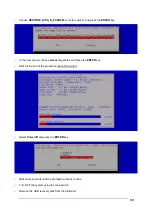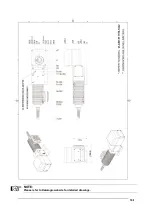
95
ABSORPTION OF LASER RADIATION
Human skin absorbs electromagnetic radiation in different ways depending on the wave length of the
radiation.
Both the eye and skin have a “predisposition” for accepting certain wave lengths, and are more
unresponsive to absorbing others. In the specific case of the Eye, the Cornea and Crystalline lens let all the
wave lengths from 400 to 1400 nm pass and reach the Retina, even with various attenuations. They include
the range from visible light to IRA infrared. Thus Nd:YVO
4
laser radiation (1064 nm wavelength) is included
in this range and
leads to direct Retina exposure!
In terms of the Skin, the “biological window” has different absorption percentages but is not dissimilar in
terms of wave length. The maximum exposure values for Skin are much different compared to those
tolerated by the Eye.
Figure 70: Eyeball section.
In terms of the damage mechanism that absorbed radiation can cause, it also depends on the wave length.
Short lengths (ultraviolet: UV-C 180-280nm; UV-B 280-315 nm, UV-A 315-400 nm) generally cause photo-
chemical effects:
•
cataract, or opacification of the crystalline lens
•
melanic coloring, or reddening of the skin
Greater wavelengths (infrared: IR-A 780-1400 nm; IR-B 1400 3000 nm; IR-C 3000-10
E6
nm) generally cause
thermal effects:
•
detachment or photocoagulation of the retina
•
burning of the skin
The degree of injury obviously depends on the
amount of absorbed radiation
and the
instantaneous
power
of the radiation source.
CLASSIFICATION AND DANGER LEVEL
Regulations have established different classes of Laser danger based on the ability to injure people, from
Laser Class 1 (basically safe in all conditions) to Laser Class 4 dangerous in various conditions.
Lasers which can produce risks, not only for direct or reflected radiation, but also for scattered radiation
belong to Class 4. These Laser sources can also have a significant risk for the Skin and fire risk for
flammable material. For these reasons, the User must put into effect all measures aimed at containing the
radiation to make sure that it is terminated at the end of its useful path. The operator must also be informed
of the risks from exposure to Laser radiation and must wear specific I.P.D. (individual protection devices)
including goggles that protect against radiation and are certified as suitable for this use.
WARNING!
The Vl
ase™ marking system contains a
Class 4 invisible
laser source.
Содержание VLASE IR 1PWX-TLS2
Страница 1: ...USER S MANUAL VLASETM IR ...
Страница 34: ...VLASETM IR 34 2 2 6 CONNECTION EXAMPLES Figure 27 Connection examples ...
Страница 59: ...USE AND OPERATION 59 4 Edit Filling properties such as filling type interline etc using the Properties browser ...
Страница 78: ...VLASETM IR 78 6 6 4 RACK HANDLES Handles for rack fastening are available on request Figure 64 Rack handles ...
Страница 85: ...85 EXTERNAL LABEL PLACING Figure 67 Positioning of external labels rack ...
Страница 86: ...86 Figure 68 Positioning of external labels resonator ...
Страница 90: ...90 BLOCK DIAGRAM VLASETM SAFETY LOGIC DETAILS FOR AUTOMATIC PRODUCTION LINE ...
Страница 108: ...108 APPENDIX G MECHANICAL DRAWINGS ...
Страница 109: ...109 NOTE Please refer to Datalogic website for detailed drawings ...
Страница 112: ......
















































